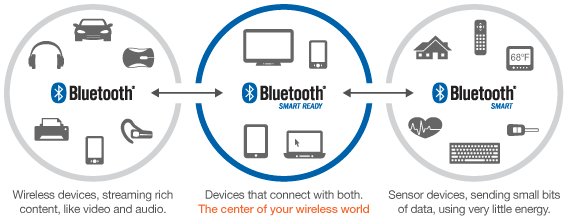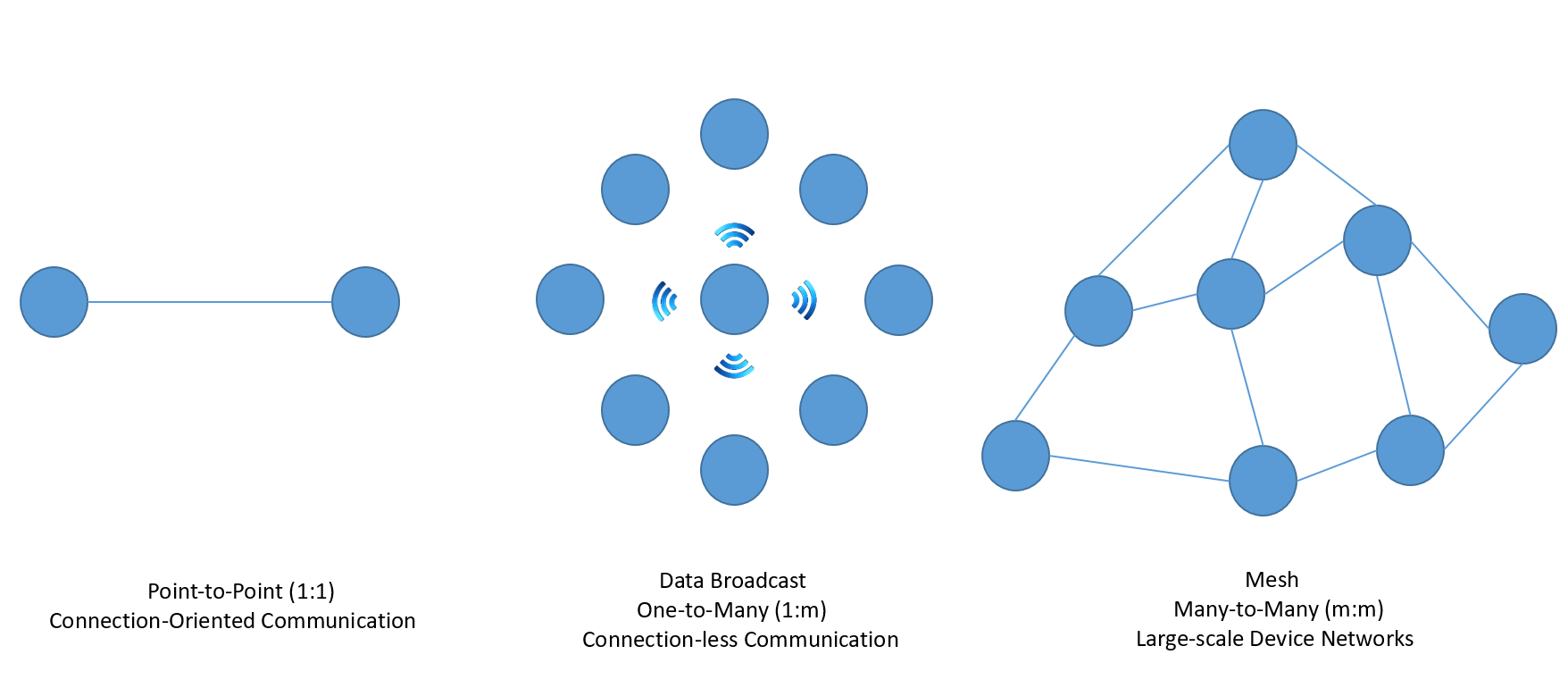Are Bluetooth & Bluetooth Low Energy (BLE) Forms of Active RFID?
Bluetooth & Bluetooth Low Energy: The Communication
Bluetooth
Bluetooth is a short-range, wireless technology standard used for exchanging data between two or more devices. Bluetooth uses the 2.4 GHz to 2.4835 GHz frequency band on the radio frequency spectrum, and the range is divided into 80 individual channels. Bluetooth version 1.0 was introduced in 1998 and has slowly developed into a widespread technology standard, available on most smart devices, vehicles, audio devices (i.e., speakers and headphones), and video devices (i.e., monitors and televisions).
Over time, the Bluetooth standard has steadily grown and evolved, from the original Bluetooth 1.0 to the current version at the time of this article—Bluetooth 5.2. With each new version released, new features, modes, power options, and even communication topology and read ranges have been added or updated, which makes each version of Bluetooth dynamic.
Bluetooth Low Energy (BLE)
Bluetooth Low Energy (BLE) was released in Bluetooth version 4.0 in 2010. (1) BLE communicates on the same 2.4 GHz frequency range, with a similar read range, as the Classic Bluetooth standard; the main difference is that BLE consumes, on average, approximately 1/10 the amount of power. The low power consumption is ideal for communication between electronic devices, equipment, sensors, and other devices that are battery powered (i.e., Fitbit or other health-monitoring devices).
Are Bluetooth & BLE forms of RFID?
Bluetooth classic and BLE technology standards utilize RF signals to communicate and exchange identification information, which means that both standards fit in the category of radio frequency identification (RFID). Bluetooth classic and BLE devices communicate via RF waves on the 2.4 GHz frequency, and usually include a battery, which classifies them as active RFID technologies. Both technology standards are also used for uniquely identifying devices, items or assets, or locations.
Generally, Bluetooth and active RFID are considered to be disparate because the specific way two Bluetooth devices communicate, including the specific protocols and standards, has been registered and patented with the Bluetooth name.
Bluetooth 4.0/BLE Focus
Bluetooth Device Groupings
To dig deeper into Bluetooth 4.0—especially, BLE and the way it is used for traditional RFID use cases—a basic understanding of the device types and their methods of communication is necessary.

Bluetooth Classic Devices
First Introduced: Bluetooth 1.0, continually updated in later versions
Functionality: Mainly receive communication
Bluetooth classic devices are wireless devices that stream large packets of content, such as phone calls, videos, and music played directly from a phone, computer, or tablet.
Examples: Headphones, Printers, and Vehicular hands-free systems
Bluetooth Smart Ready Devices/Bluetooth High Speed
First Introduced: Bluetooth 3.0, continually updated in later versions
Functionality: Receive and send communication
Bluetooth Smart Ready devices are wireless devices that communicate by sending and receiving information with BLE and Bluetooth classic, as well as other Bluetooth Smart Ready devices. These devices are the central devices in a Bluetooth system.
Examples: Smart Phones, Tablets, and PCs
Bluetooth Smart/Bluetooth Low Energy/BLE
First Introduced: Bluetooth 4.0, continually updated in later versions
Functionality: Mainly send communication
Bluetooth Smart devices are wireless devices that primarily communicate by sending small pieces or packets of data, using a low amount of energy, to Bluetooth Smart Ready devices.
Examples: Heart Rate Monitors and Internet of Things (IoT) Devices, such as smart doorbells, cameras, etc.
Bluetooth Topology/Network Topology
Topology is the arrangement of elements within a communication network and the elements’ chain of communication. Bluetooth 1.0 introduced point-to-point topology in 1998, but the other two topologies were not introduced until the release of Bluetooth 4.0 and the emergence of BLE.

Point-to-Point—Bluetooth 1.0+
Bluetooth Point-to-Point Topology is the most common topology for everyday use. Point-to-point topology is simply one device communicating with another device, whether that communication is for file/data transfer or audio streaming, which is also called “pairing.” (3)
Broadcast—Bluetooth 4.0+
Bluetooth Broadcast topology was enabled in Bluetooth 4.0 in order for one device to communicate or broadcast information simultaneously to many devices. This communication topology is used for sharing retail point-of-interest information and indoor navigation and communicating a command to several IoT BLE devices concurrently (i.e., simultaneously turning off all BLE smart lights in a house).
Mesh Networking—Bluetooth 4.0+
BLE Mesh Network topology is a many-to-many communication protocol that allows the interconnection of Bluetooth-enabled devices in a mesh arrangement with self-healing characteristics, where there is not one defined path of communication.(2) Basically, these BLE devices can use each other to send a signal back to a main or central Bluetooth device, thus enabling a longer communication range. Instead of all BLE peripheral devices in a system limited to the ~20m radius of the central Bluetooth device, now peripheral devices can be used as a chain to achieve extended ranges.
One major benefit of Mesh Networks, besides the extended communication range, is the ability for any peripheral device to communicate with any other peripheral device. In Mesh Networks, there is not a structured, specific path of communication from each peripheral device back to the central device. If one peripheral device becomes inoperable, it will not shut down the entire system but other BLE tags or devices can send their small data packages to any other peripheral device within range, which is then routed through a chain and back to the central Bluetooth device. (2)(3)
How is Bluetooth/BLE used in traditional active RFID use cases?
BLE is used in traditional RFID use cases by attaching BLE tags to items or assets and using Broadcast or Mesh Network topology to extend the communication range. BLE tags are available in different form factors from lower cost non-durable options to sealed and rugged options similar to RFID hard tags, however they typically contain more functionality.
BLE tags that are used in traditional RFID use cases can be as simple as a tag that beacons its identifier and/or location or as complex as a BLE sensor or actuator.
BLE modules can be placed on items or in locations in order to
● locate an item easily,
● monitor an environment, or
● start, stop, or connect communication (i.e., a BLE Smart Plug)
Once attached to assets, BLE modules can then begin to beacon their information (e.g., identification, location, sensor data, etc.) either via broadcast or in a mesh network to each other, which is then relayed back to a central Bluetooth device for data collection. Broadcast BLE beacons can also be readily acknowledged by other mobile devices like phones, tablets with BLE capability negating the requirement of a dedicated mobile reader to read the tags. These BLE tags can be instrumental in locating items or assets in large areas, especially in indoor locations where GPS coverage may not be reliable. (2)
Conclusion
Do you have any interesting facts about using Bluetooth 4.0 or BLE for item or asset tracking? Comment below to tell us more; we love first-hand information! For more information on all things RFID, comment below or contact us.
(1) - https://en.wikipedia.org/wiki/Bluetooth_Low_Energy
(2) - Subbu Nambi, Jovix
